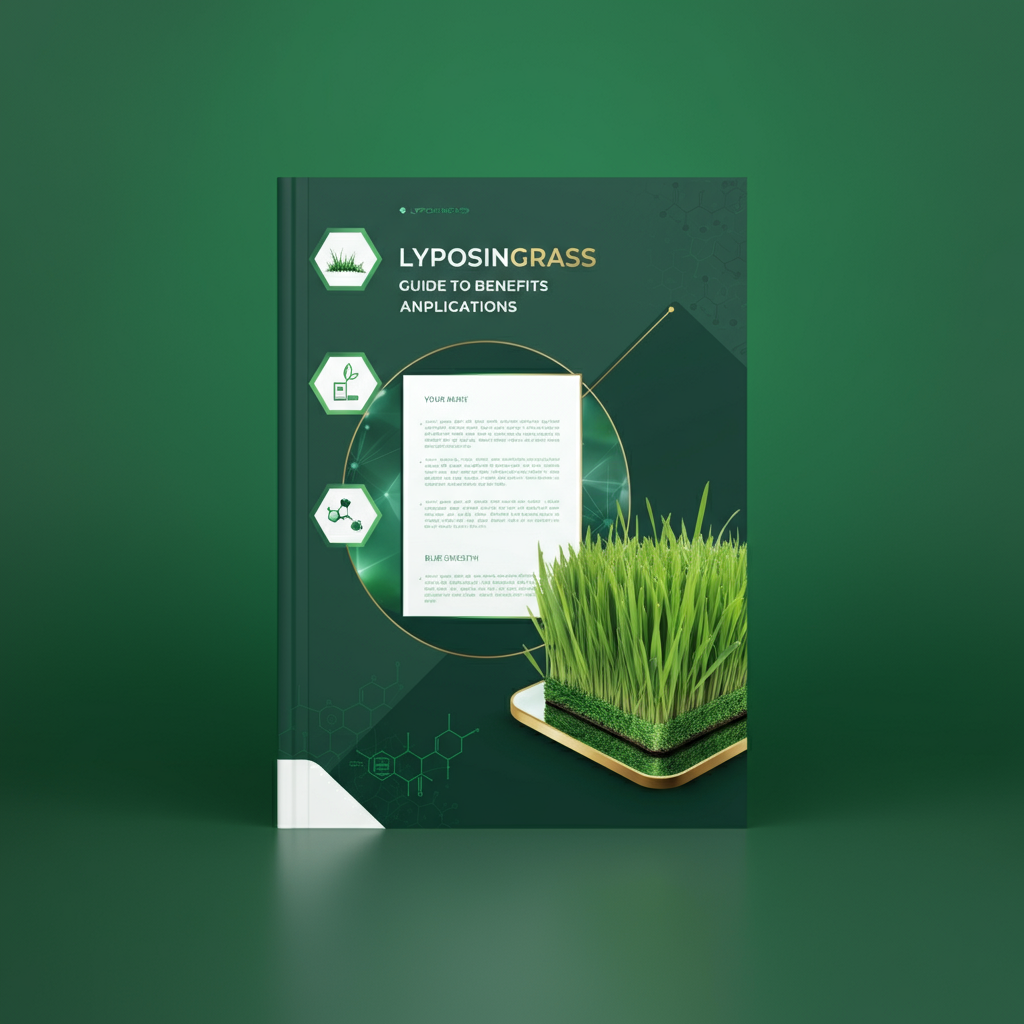In the rapidly evolving landscape of biotechnology and sustainable materials, few innovations have captured the attention of researchers and industry professionals quite like Lyposingrass. This remarkable biological compound has emerged as a game-changing substance with applications spanning multiple sectors, from healthcare to agriculture and beyond. As we navigate through 2025, understanding the potential and practical applications of Lyposingrass becomes increasingly crucial for professionals across various industries.
What is Lyposingrass?
Lyposingrass represents a breakthrough in bioengineered materials, characterized by its unique molecular structure that combines lipophilic properties with grass-derived polysaccharides. This hybrid compound was first synthesized in laboratory conditions by mimicking the natural cellular processes found in specific prairie grass species, particularly those adapted to extreme environmental conditions.
The compound’s name derives from its dual nature: “lypo” referring to its fat-soluble characteristics, and “singrass” indicating its origin from specialized grass proteins. What makes Lyposingrass particularly fascinating is its ability to maintain stability across various pH levels while demonstrating remarkable biocompatibility with both plant and animal tissues.
Origins and Development History
The discovery of Lyposingrass traces back to 2019 when agricultural researchers studying drought-resistant grass varieties in the American Midwest noticed unusual cellular structures that seemed to protect these plants during extreme weather conditions. These structures contained a previously unknown compound that could store and release moisture while maintaining cellular integrity.
Initially developed as a research curiosity, Lyposingrass caught the attention of biotechnology companies when scientists realized its potential applications extended far beyond agriculture. The compound’s unique ability to form protective barriers while remaining permeable to specific nutrients made it an ideal candidate for various industrial applications.
By 2023, the first commercial-grade synthesis processes were established, and by 2025, Lyposingrass production has scaled to meet growing demand across multiple industries. The development process required overcoming significant challenges related to mass production while maintaining the compound’s delicate molecular structure.
Unique Properties and Characteristics
Lyposingrass possesses several distinctive properties that set it apart from conventional materials:
Selective Permeability: The compound demonstrates remarkable selective permeability, allowing beneficial substances to pass through while blocking harmful elements. This property makes it invaluable for filtration and protective applications.
Thermal Stability: Unlike many organic compounds, Lyposingrass maintains its structural integrity across a wide temperature range, from -40°F to 180°F, making it suitable for diverse environmental conditions.
Biodegradability: Despite its stability during use, Lyposingrass breaks down completely into harmless organic compounds when exposed to specific enzymatic conditions, addressing environmental sustainability concerns.
Adaptive Response: Perhaps most remarkably, Lyposingrass can modify its permeability based on environmental triggers, essentially “smart” behavior that responds to changing conditions.
Health and Medical Applications
Pharmaceutical Delivery Systems
In the healthcare sector, Lyposingrass has revolutionized drug delivery systems. Its selective permeability allows for controlled release of medications, ensuring optimal dosing while minimizing side effects. Pharmaceutical companies have integrated Lyposingrass into capsule coatings and transdermal patches, resulting in more effective treatments for chronic conditions.
Wound Healing and Tissue Engineering
Medical researchers have discovered that Lyposingrass-based dressings accelerate wound healing by maintaining optimal moisture levels while preventing bacterial contamination. The compound’s biocompatibility makes it ideal for tissue engineering applications, where it serves as a scaffold for cellular regeneration.
Diagnostic Applications
The compound’s unique optical properties have led to its use in advanced diagnostic equipment. Lyposingrass-enhanced sensors can detect minute biological changes, enabling earlier disease detection and more precise monitoring of treatment progress.
Agricultural Revolution
Crop Protection and Enhancement
Agriculture has perhaps seen the most dramatic impact from Lyposingrass applications. When applied as a foliar spray, the compound creates a protective barrier around plant leaves that reduces water loss while allowing photosynthesis to continue unimpeded. Farmers using Lyposingrass treatments report 15-20% increases in crop yields, even during drought conditions.
Soil Improvement
Lyposingrass has shown remarkable potential as a soil conditioner. When incorporated into soil, it improves water retention and nutrient distribution, creating optimal growing conditions for various crops. This application has proven particularly valuable in arid regions where traditional agriculture struggles.
Sustainable Farming Practices
The biodegradable nature of Lyposingrass aligns perfectly with sustainable farming initiatives. Unlike synthetic alternatives, it leaves no harmful residues and actually enriches the soil as it decomposes, supporting long-term agricultural sustainability.
Technological Innovations
Advanced Materials and Manufacturing
The technology sector has embraced Lyposingrass for developing next-generation materials. Its unique properties make it ideal for creating flexible, durable surfaces for electronic devices. Several major tech companies have incorporated Lyposingrass-based materials into smartphone screens and wearable devices, providing enhanced durability and user experience.
Environmental Monitoring
Lyposingrass-based sensors have become crucial tools for environmental monitoring. These sensors can detect pollutants and environmental changes with unprecedented sensitivity, providing real-time data for climate research and environmental protection efforts.
Energy Storage Solutions
Research into Lyposingrass applications in energy storage shows promising results. The compound’s ability to maintain structural integrity under stress makes it suitable for advanced battery technologies, potentially extending battery life and improving energy density.
Real-World Implementation Examples
Case Study: Midwest Agricultural Cooperative
A large agricultural cooperative in Iowa implemented Lyposingrass treatments across 10,000 acres of corn and soybean fields. Results showed a 22% increase in drought resistance and an 18% improvement in overall yield compared to control fields using conventional treatments.
Case Study: Urban Vertical Farm
An urban vertical farming operation in Singapore integrated Lyposingrass-enhanced growing mediums throughout their facility. The implementation resulted in 30% faster growth rates and significantly reduced water consumption, demonstrating the compound’s effectiveness in controlled agricultural environments.
Case Study: Medical Device Manufacturing
A leading medical device manufacturer incorporated Lyposingrass into their implantable sensor coatings. The biocompatible properties of the compound reduced rejection rates by 40% while improving sensor accuracy and longevity.
Future Developments and Potential
Emerging Applications
Research continues to reveal new potential applications for Lyposingrass. Current studies explore its use in water purification systems, biodegradable packaging materials, and even space exploration equipment where its unique properties could prove invaluable in extreme environments.
Scalability and Production
As demand grows, researchers focus on developing more efficient production methods. New synthesis techniques promise to reduce production costs while maintaining quality, making Lyposingrass accessible to smaller companies and developing markets.
Genetic Optimization
Scientists are exploring ways to optimize the original grass species through selective breeding and genetic modification, potentially creating variants of Lyposingrass with enhanced properties for specific applications.
Challenges and Limitations
Production Complexity
Despite advances in synthesis, producing high-quality Lyposingrass remains complex and resource-intensive. The delicate molecular structure requires precise control during manufacturing, limiting production scalability.
Cost Considerations
Current production costs remain higher than conventional alternatives, though economies of scale are gradually reducing this barrier. For many applications, the superior performance justifies the additional cost, but price sensitivity remains a consideration for widespread adoption.
Regulatory Compliance
As with any novel compound, navigating regulatory approval processes across different industries and regions presents ongoing challenges. While safety testing has shown positive results, comprehensive long-term studies continue.
Storage and Handling
Lyposingrass requires specific storage conditions to maintain its properties, presenting logistics challenges for widespread distribution. Specialized handling procedures and equipment add complexity to supply chain management.
Conclusion
Lyposingrass represents a significant advancement in materials science with far-reaching implications across multiple industries. Its unique combination of properties—selective permeability, thermal stability, biodegradability, and adaptive response—positions it as a versatile solution for modern challenges in healthcare, agriculture, and technology.
As we progress through 2025, the continued development and refinement of Lyposingrass applications promise to address some of our most pressing needs, from sustainable agriculture to advanced medical treatments. While challenges remain in production scalability and cost optimization, the compound’s proven benefits suggest a bright future for this innovative material.
For professionals considering Lyposingrass integration into their operations, now represents an opportune time to explore its potential. As production methods improve and costs decrease, early adopters will likely gain significant competitive advantages in their respective markets. The journey of Lyposingrass from laboratory curiosity to industrial game-changer demonstrates the power of innovative thinking and scientific persistence in creating solutions for tomorrow’s challenges.



